A number of my black pines are turning eight this year. Some are starting to look like young bonsai. Others simply look young. As none have grown to the size I have in mind for them, the work at this stage is straight forward.
I’ve trained the tree below in the exposed root style. This year’s goal for the tree below is increased growth. To keep it from blowing over, I removed the uppermost shoot.
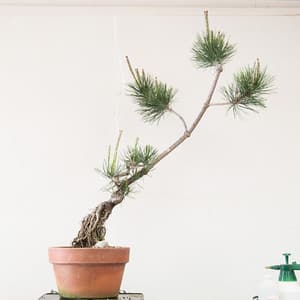
Before cutback
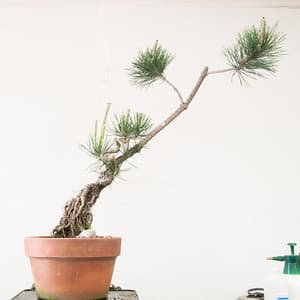
After cutback
I have yet to select a trunk or main branches, but I suspect the final tree will be somewhere in this area.
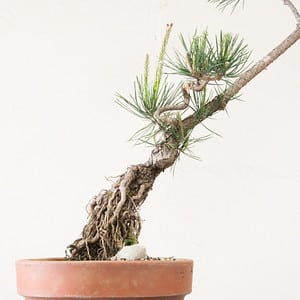
Exposed root pine
Most of my young pines have small shoots near the base of the trunk that will form the future branches. Longer escape branches serve to thicken the trunk. To keep the lower branches on the tree below in check, I cut them back and wired them down.
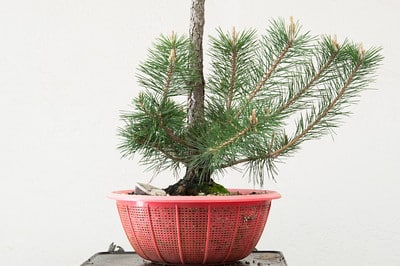
8yr-old pine with long shoots
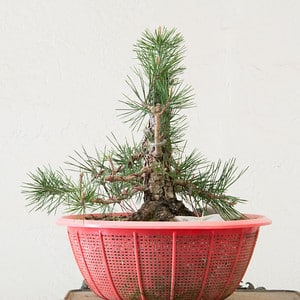
After cutback and wiring
I also replaced the tree’s trunk by wiring a branch upwards and tying it to the stub from the previous trunk. Changing the main trunk like this is a good way to add movement and produce taper.
Another young pine was getting floppy. I wired the trunk a few years ago with some very tight curves. The weight from the long escape branch made the tree bounce around in the wind. To keep the branch from moving around too much and snapping the trunk, I removed some of the excess foliage.
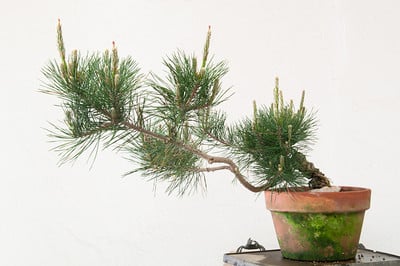
Before cutback
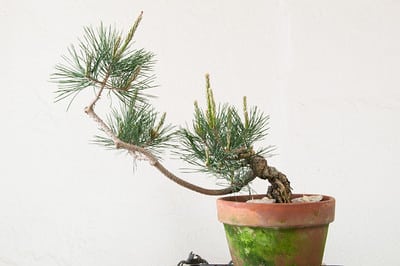
After cutback
Some trees are puzzles to me. I’ve found that some of the trickiest – read: least attractive – simply require more time before the future direction becomes clear. I’m hoping light cutback and another year or three of new growth may help with this one.
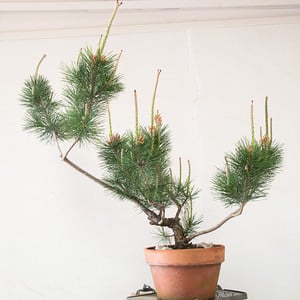
Future bonsai?
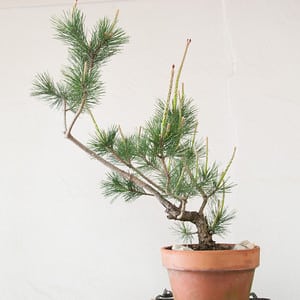
Future landscape tree?
Some of the smaller trees produce no strong feelings in me. I’ll let these grow another year before making any cuts.
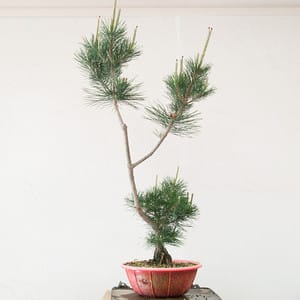
8yr-old pine
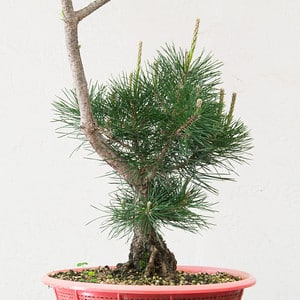
Plenty of small branches
I really like this stage of development because the work is simple and the effect on the tree’s future can be huge. Some of my most hopeless cases have turned into really fun trees. The rest are growing nicely – as landscape trees.
Subscribe to Bonsai Tonight
New Posts Delivered Every Tuesday and Friday
Mark says
Hi Jonas,
Nice post about your pines. Could you tell me is there any reason that you chose to prune and wire these pines when in active growth in spring rather than doing in in late winter just befor they bud?
Mark
tmmason10 says
Looks good Jonas. Have you written about some of the techniques used to get them to this stage? Just a lot of experimenting?
Jonas Dupuich says
Hi Tom – I don’t have many posts written about pines at this stage. Some are younger (0-1 year) and some older (16-18 years). I’m now chronicling my younger pines so in time I’ll be able to show the years in between. My approach has been straight out of the techniques in Bonsai Today 12 and 20 with some alteration informed by experience of how the trees grow in Northern California.
Mark – the sole reason I’m working on the trees now is that I didn’t get around to it earlier. I’d likely bend and cut more were the trees dormant, but since they have started to grow, I’m mostly making slight modifications.
Zack Clayton says
Jonas, I see you grow in several different containers. Is your soil mix different from the terra cotta pots to the collanders? It seems that evaporation would be very different. And who took care of your trees while you were in Japan? Club members or your own apprentice?
Jonas Dupuich says
Hi Zack – you’re right, the trees in colanders dry out much faster than those in terra cotta pots. Sometimes I use wetter soil mixes for the trees in colanders (more akadama, less pumice), other times I put them on less exposed benches.
Apprentices and club members sound like great ideas! I tend to rely on friends, neighbors, and an automatic system.
Dick van Dreven says
Hi Jonas,
Thanks for this post.I really liked it! (as I like most of your posts! )
I understand that the process of culling out trees still continues, even afte 8 or nine years?
Are you really going trough all that trouble to create landscape trees?
Out of 100 seedlings, can you estimate how many bonsai you end up with?
Jonas Dupuich says
Hi Dick – You’ve asked one of my favorite questions! Yes, I cull out trees quite late in the process. For the most part, I’m watering and feeding a lot of trees, but not putting a lot of time into them. When the trunks get to the desired sizes, I’ll decide which to keep and which to move along. In the past, Of 100 planted seeds, 80 may sprout, 60 survive the seedling-cutting process, 30 become bonsai, and 3 become really nice trees. Give or take. The more I’ve worked with pines, the more that come out nice. That said, many seedlings lack good bonsai characteristics like compact needles, straight needles, or short internodes. Even good technique cannot yield good bonsai in these cases so I move these trees along as soon as possible.
Thanks!
Jonas
Richard Dorfman says
A very timely article for me, Jonas. Thank you. Last November, as an experiment I purchased 60 seedlings (1-2 years old) half of which are red pine or black mikawa pine, potted them up, put 5-6 pots in a tub with mulch around and stored in my unheated garage in Vermont through winter. Something to do while my bonsai trees were in winter storage. 58 of the seedlings made it through winter, budded out and are growing strong as I transition them outdoors (Spring comes late in VT). I assume I should really do no more than allow them to grow this season (sunshine, feeding and water). Anything else to consider? Also, do you have any thoughts about transfering some to Rootmaker pots to develop a spread root system? Thanks.
Jonas Dupuich says
Hi Richard – if the seedlings grew significantly last year, say 5-8″, then you can wire the trunks. The ideal time for this is before the spring candles start moving. This is also the time to start thinking about whether you want to develop larger or smaller trees and make the bends accordingly.
Some techniques encourage letting the wire cut in to cause the trunk to swell. This can work well, but letting the wire cut in too far can cause problems.
I’ve used rootmaker pots, terra cotta pots, collanders and gallon cans. Rootmaker and related pots are great. They require more water than plastic or clay pots which is ok since the goal is vigorous growth at this stage. Sounds like your trees are off to a good start!